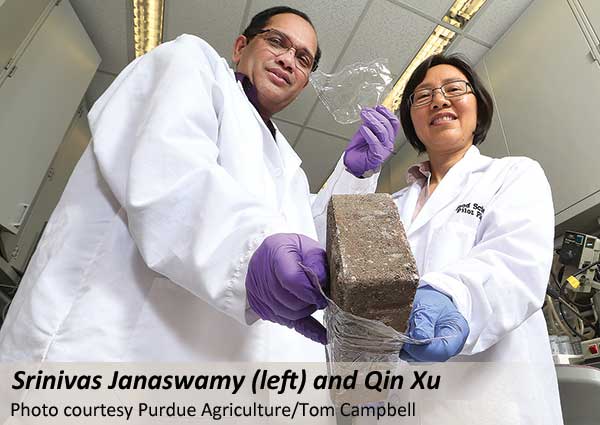Biodegradable cellulose-based films; Floating urban dairy farm; Protein boosts rice yield
CUTTING EDGE TECHNOLOGY
 Biodegradable, transparent cellulose-based films
Biodegradable, transparent cellulose-based films
Purdue University researchers have developed tough, flexible, biodegradable films from cellulose, the main component of plant cell walls. The films could be used for products such as food packaging.
Food scientists Srinivas Janaswamy and Qin Xu engineered the cellophane-like material by solubilizing cellulose using zinc chloride, a common inorganic salt, and adding calcium ions to cause the cellulose chains to become tiny fibers known as nanofibrils, greatly increasing the material’s tensile strength. The zinc chloride and calcium ions work together to form a gel network, allowing the researchers to cast the material into a transparent, food-grade film.
Cellulose’s abundance, renewability and ability to biodegrade make it a promising substitute for petroleum-based products. While a variety of products such as paper, cellophane and rayon are made from cellulose, its tightly interlinked structure and insolubility—qualities that give plants strength and protection—make it a challenging material to work with.
Janaswamy and Xu loosened the cellulose network by adding zinc chloride, which helps push cellulose’s closely packed sheets apart, allowing water to penetrate and solubilize it. Adding calcium ions spurs the formation of nanofibrils through strong bonds between the solubilized cellulose sheets. The calcium ions boost the tensile strength of the films by about 250%.
The production process preserves the strength and biodegradability of cellulose while rendering it transparent and flexible. “Products based on this film can have a no-waste lifecycle,” said Xu, research assistant professor of food science. “This process allows us to create a valuable product from natural materials—including low-value or waste materials such as corn stover or wood chips—that can eventually be returned to the Earth.”
Floating urban farm to produce dairy products
Three companies in the Netherlands have joined forces to construct a floating dairy farm that will produce milk and yogurt once its operational early next year. Situated in the port of Rotterdam, the 130-ft x 105-ft floating transparent structure will house 60 dairy cows and grow its own grass feed. Urine and manure will be collected and utilized in the form of fertilizer and energy.
The developers of the project hope that the floating farm will serve as a model for producing sustainable food in urban areas that are close to consumers, thus reducing transportation costs and greenhouse gases. In addition to dairy foods production, the facility will also serve as a lab where corporate and academic researchers can study sustainable food production, energy and water handling and waste treatment. The floating farm will host guided tours of children and students, enabling visitors to see first-hand the entire process of milk handling, animal welfare and high-tech robotics.
Protein boosts rice yield 50%
In collaboration with researchers at Nanjing Agricultural University in China, senior scientist Tony Miller with the John Innes Centre in the UK has developed rice crops with an improved ability to manage their own pH levels, enabling them to take up significantly more nitrogen, iron and phosphorous from soil and increase yield by up to 54%.
Rice is a major crop, feeding almost 50% of the world’s population and has retained the ability to survive in changing environmental conditions. The crop is able to thrive in flooded paddy fields, where the soggy, anaerobic conditions favor the availability of ammonium. It can also grow in much drier, drained soil, where increased oxygen means more nitrate is available.
Rice contains a gene called OsNRT2.3, which creates a protein involved in nitrate transport. This one gene makes two slightly different versions of the protein: OsNRT2.3a and OsNRT2.3b. Following tests to determine the role of both versions of the protein, Miller’s team found that OsNRT2.3b is able to switch nitrate transport on or off, depending on the internal pH of the plant cell.
When this “b” protein was overexpressed in rice plants, they were better able to buffer themselves against pH changes in their environment. This enabled them to take up much more nitrogen, as well as more iron and phosphorus. These rice plants gave a much higher yield of rice grain (up to 54% more yield), and their nitrogen use efficiency increased by up to 40%.
“Now that we know this particular protein found in rice plants can greatly increase nitrogen efficiency and yields, we can begin to produce new varieties of rice and other crops,” declared Miller. “These findings bring us a significant step closer to being able to produce more of the world’s food with a lower environmental impact.”
If you are working on or know of some cutting edge technology that you would like to be featured in this column, please send an email to [email protected].
